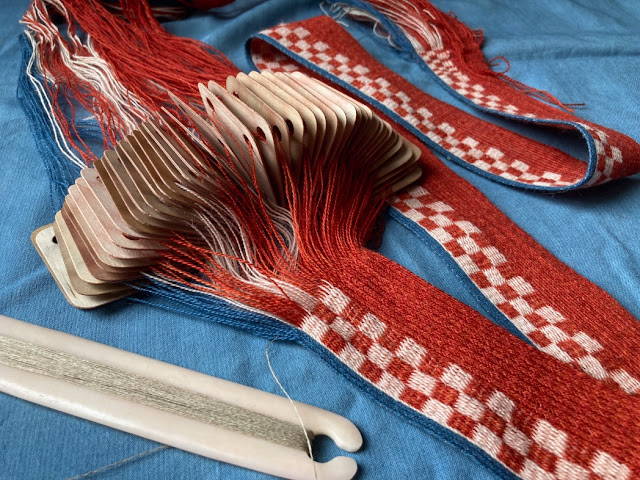Bereits 1972 wurde in der spanischen Stadt Baza eine bemalte Statue gefunden, die in das 4. Jhd. v. Chr. datiert wurde.
Die Farben waren schon sehr vergangen, aber man konnte immer noch die Farbenpracht erahnen.
Ein Rekonstruktionsversuch wurde 2011 im Archaeological Textiles Newsletter 52 veröffentlicht. Allerdings wurde dort die Borte in blau und rot gewebt.
2021 gab es eine neuen Versuch der Complutense University of Madrid, die Farben mit einer digtalen Fotografiertechnik wieder lebendig zu machen.
Es gelang und die Abwesenheit von Farbe in dem Karoteil der Borte fiel mir besonders auf.
Und so habe ich versucht diese Borte zu rekonstruieren.
As early as 1972, a painted statue was found in the Spanish town of Baza, which was dated to the 4th century BC.
The colours were already very much gone, but one could still guess the colourfulness.
An attempt at reconstruction was published in Archaeological Textiles Newsletter 52 in 2011. However, the band was woven in blue and red.
In 2021, there was a new attempt by the Complutense University of Madrid to bring the colours back to life using a digtal photography technique.
It succeeded and the absence of colour in the check part of the band particularly caught my eye.
And so I tried to reconstruct this band.
Da es sich bei der Vorlage um eine Statue handelt und nicht um einen Textilfund, kann man nicht mit 100% Sicherheit sagen, wie die Borte gewebt wurde.
Zu der Zeit gab es Brettchengewebe, man kann es mit dieser Technik damit machen und deswegen ist es eine von mehreren Möglichkeiten. Es ist eine Interpretation. Hier werden wir nie den passenden Textilfund haben, wo wir wissen werden, ob es jetzt Ripsbindung oder Brettchengewebe war.
Since the original is a statue and not a textile find, it is not possible to say with 100% certainty how the band was woven.
At that time, tablet weaving was available, it can be done with this technique and therefore it is one of several possibilities. It is an interpretation. Here we will never have the right textile find where we will know whether it was rep weave or tablet weaving.
Ich habe 48 Brettchen mit 20/2 Wolle, die mit Krapp und Indigo gefärbt aufgezogen und das Karo als einseitiges Doubleface gewebt. Die Borte ist 4,5 cm breit geworden. Viel zu schmal für die Dame von Baza. um die geschätzte Breite von 9 cm zu erreichen, müsste man mit ca. 100 Brettchen weben.
I made 48 tablets with 20/2 wool dyed with madder and indigo and wove the check as a one-sided doubleface. The band has become 4.5 cm wide. Much too narrow for the lady of Baza. To achieve the estimated width of 9 cm, you would have to weave with about 100 tablets.
Literatur:
Ida Demant, From stone to textile: constructing the costume of the Dama de Baza,
Archaeological Textiles Newsletter 52
Teresa Chapa Brunet, María Belén Deamos, Alicia Rodero Riaza, Pedro Saura Ramos, Raquel Asiain Román, La Dama de Baza. Nuevas aportaciones a su estudio iconográfico a través del color y la fotografía, in Boletín del Museo Arqueológico Nacional, 40/2021
Bild der Statue/picture of the statue: Courtesy Pedro Saura






Keine Kommentare:
Kommentar veröffentlichen